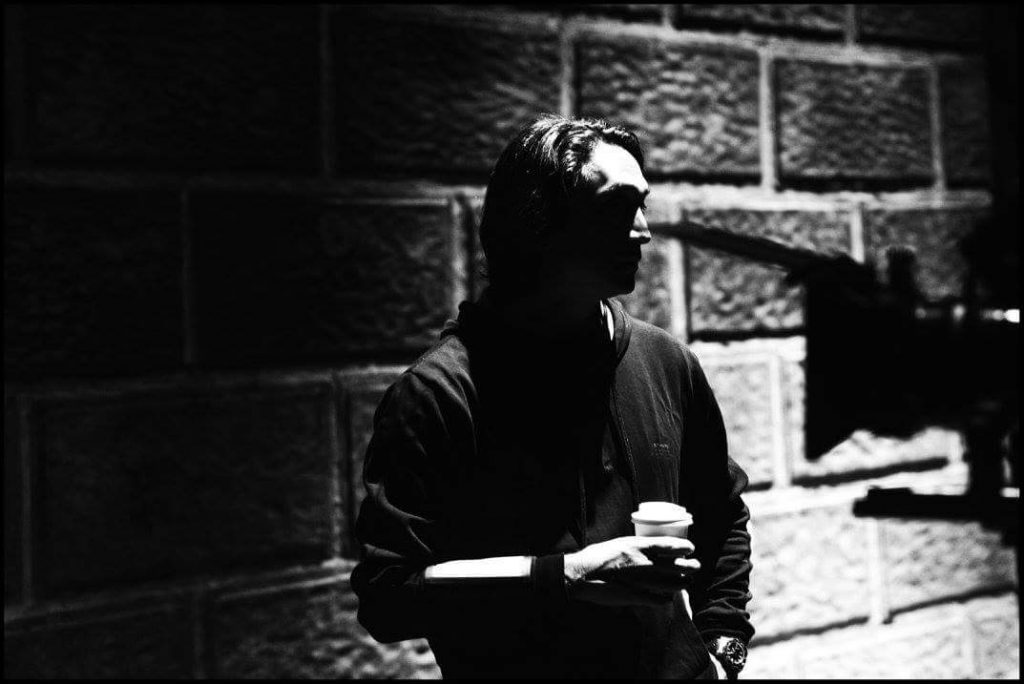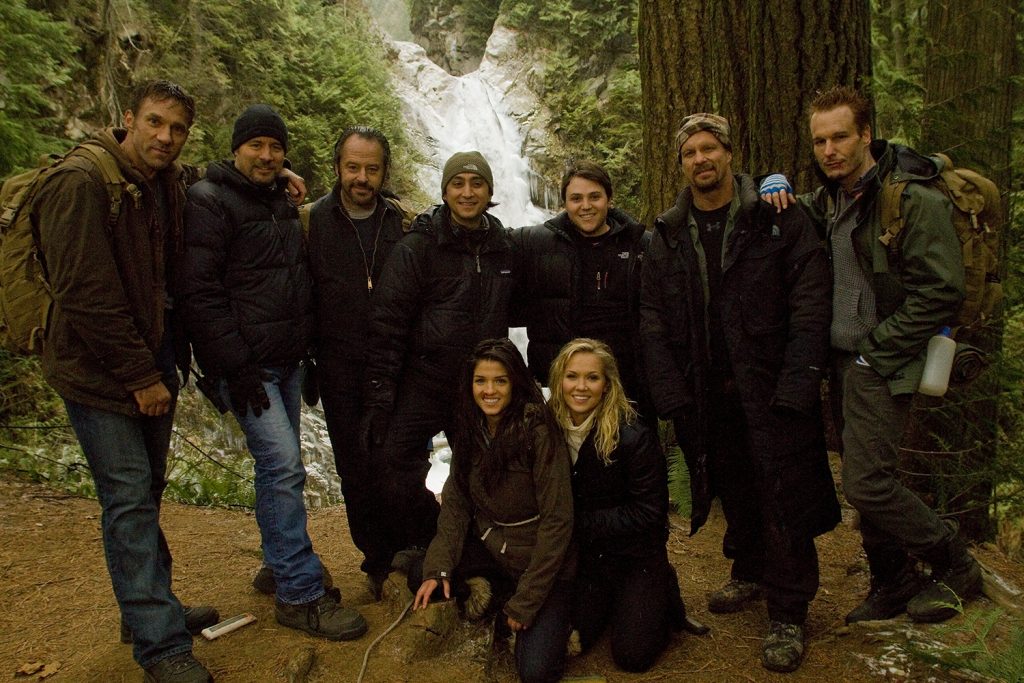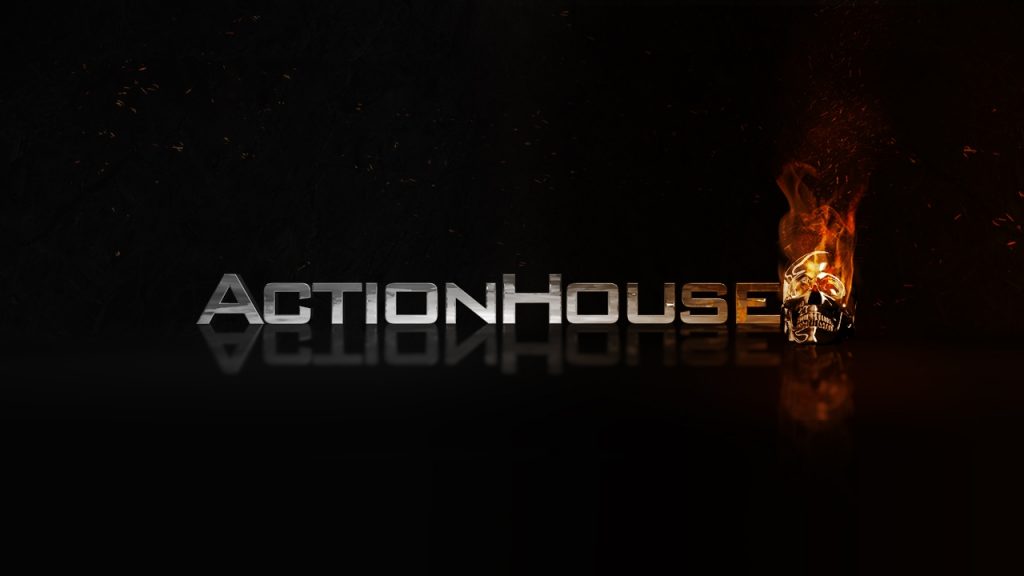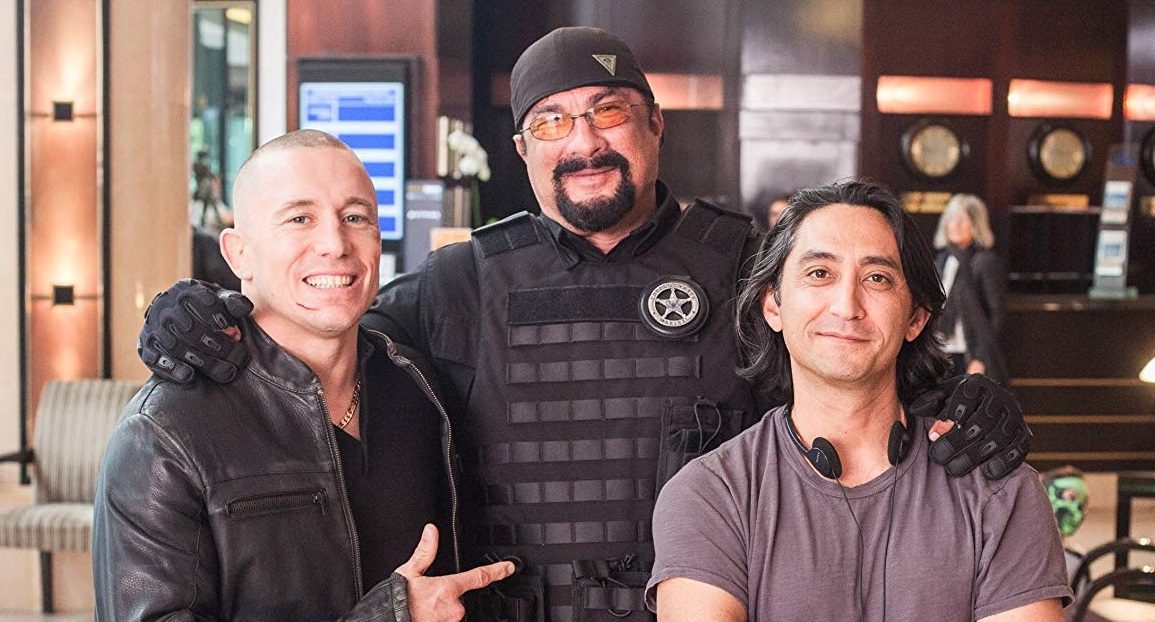I decided to start off the year of 2020 by providing an interview for one of indie Action cinema’s favorite talents: Keoni Waxman. Here was that special (and beyond generous) interview:
You grew up in Hawaii. Have you any stories on your early life that you care to share?
I grew up on Oahu in an area called Kahala which is behind Diamond Head (that you see in every post card of Waikiki). It was pretty amazing although maybe not for all the reasons you would think. We pretty much had Waikiki as a playground so at an early age we were often running wild amongst the tourists visiting the island. Makes for a pretty healthy imagination as well as exposure to many walks of life. So in a sense we were in a bustling international city – even though it was totally laid back Hawaii. That said, we also had international cinema and TV (mainly from Japan) that I watched all the time as a kid. My father was into Samurai films so he would take me to theaters in the dodgy parts of town to watch the latest films when I was super young – my earliest memory of watching a movie was waking up in the theater after having fallen asleep to see two samurai fighting in a snow storm and one guy getting his head chopped off. Obviously stuck with me into my films. I also remember watching all the Japanese superhero shows like Ultra Man and Kikaida (someone should seriously remake this show) and Rainbow Man. This was before any Star Wars (and obviously before Marvel) so it was pretty ahead of it’s time I guess. They also made action figures of these super heroes that all the kids had so I guess you could say I was influenced pretty early on to make action movies. Otherwise, it was a pretty normal surf, sun and beach upbringing in the islands.
Did you attend film school prior to getting into the business?
Yes, I went to film school at the University of Colorado, Boulder. The film department was almost non-existent when I started there but the University was near the Naropa Institute where Allen Ginsburg was living. As such there were many avant garde filmmakers living in Boulder and working at the University (Stan Brackhage, Jerry Aronson, Don Yanicito) and they made up the film department. I worked as a camera assistant in school and eventually ended up shooting for Stan Brackhage on a few of his later films. The department was small so the classes were small which was great because it allowed many of us to make our first features while still in school (I made a film called “Almost Blue” staring Michael Madsen and Trey Parker and Matt Stone made “Cannibal! The Musical” while we were students at CU together). Anyway, I ended up dropping out after making the film and moving to LA.

What were your film inspirations and influences? What is your process like when prepping for each picture?
My earliest influences were Japanese cinema starting with samurai movies and moving toward their television shows. I grew up near a drive-in movie theater so we would watch everything that played while growing up but my father was really into Peckinpah and Kurosawa so I guess I watched those films the most. In high school and college I studied a lot of Alex Cox (Repo Man) and Scorsese films – funny thing is I never really got into the 80’s action films which I find a lot of my action films seem to draw from. Later it was Soderbergh (love “The Limey”) and Fincher. Two of my all time favorite films are “King of New York” by Abel Ferrara and “The Descendants” from Alexander Payne – seemingly very different films so for different reasons – but actually not. I’ll let you guys watch them and figure out what I mean.
My prep is always the same – details, details, details. I write (or re-write) all of my films so I find that the writing process is really the beginning of my prep process and visualization. But I also shot list everything in prep so I know what my visual motifs and visual pacing will be (action is different from drama) and then work from there into production.
Prior to writing and directing, you worked in set construction and camera film loading. How did you first get to the next stage of your current directing/writing career?
Like I said I worked as a camera assistant then camera operator while in film school. And I made my first feature while in film school. So all was moving along pretty fast – and then I moved to LA. In LA things move even faster – and we have to pay the bills. I didn’t want to do anything that would take me away from writing or being able to go on location so I started working as a carpenter on film sets. I think I built sets on “Babylon Five” for two or three years – at least until I was able to tell them I was going to leave to direct a film (I think it was “I Shot a Man in Vegas”). I figured I would be back afterward but that never happened.
I Shot a Man in Vegas was one of your first pictures and a winner of Best Picture at Mystfest; Care to detail the inception of your first directing entry?
Actually it was my second film (the first was “Almost Blue”). Like I said I was a big Kurosawa fan and I really wanted to make something like “Mean Streets” meets “Rashomon” – We barely had any money but everyone was really into it. I knew the actors from hanging out with them in Hollywood and my friend had a really kickass car. So I wrote the script based on the people I knew and the car. Again we didn’t have any money to speak of so we rehearsed the film for a month then shot it in two weeks. I really enjoyed that film – and I love the score to it.

Countdown/Serial Bomber was your first foray into Action cinema. How did this second opportunity come about?
At the time film festivals were just starting to take off – sure there were the international markets/festivals like Cannes but Sundance was just starting to become the festival to show your film (we didn’t get in so a bunch of other filmmakers that year decided to start Slamdance for all the films that didn’t make it) and it was really how independent movies got a chance to be seen. “I Shot a Man In Vegas” played all over and eventually someone saw it and offered me a job adapting a Japanese novel. I did and then got the job directing the movie (which was nothing like the novel). It was a co-production with Toei Studios in Japan so we had two “big” Japanese actresses in the film. Neither spoke English and learned the script phonetically. If that wasn’t enough we were trying to do some big action on a pretty small budget. It was tough and the film is very uneven but it was fun. Again, I like some of the music in it.
Almost Blue was an unpredictable Neo-Noir, jazz music themed drama. With a moody script and Michael Madsen as the star, how did that production go?
I wrote and directed “Almost Blue” while still in film school (I was 22). Michael had just shot “Reservoir Dogs” (as in he wrapped and came directly to Denver to shoot my film) so although there was a buzz about his performance in it no one had any idea how big the movie and Tarantino was about to become. So I guess we got lucky that Michael was a Chet Baker fan and wanted to play a tenor sax player. It was tough but a lot of fun since it was in Denver where I was living at the time. I remember we had to battle the weather a lot as well – the first day of the shoot it dumped three feet of snow so we ended up painting it black to look like asphalt.
Sweepers was an uncanny mix of then-current War politics and Indiana Jones adventure. How did you get approached by Nu Image/Millennium Films for this Actioner?
I had written a script called “Pool Hall Prophets” that was making the rounds in town. A lot of people wanted to do it and a lot of actors were attaching themselves to it. Millennium had just formed and I was offered a three picture deal (“Pool Hall Prophets” being one of the pictures) if I signed with them. I did and they immediately shelved my project and said they wanted me to first make “Sweepers” in South Africa with Dolph Lundgren. I didn’t really have a choice and the idea of shooting an action film in South Africa about landmines with Dolph was pretty fucking cool right? So I said yes. It was a mistake in many ways – but there were a lot of cool things that eventually came from the deal so looking back at it I guess it was how it was supposed to be.
The Highwayman (2000) has often been described as a mix of hostage dramas, Tarantino and road movies. How did you conceive of this dark humored, action-packed crime thriller?
My good friend (and excellent writer) Richard Beattie wrote the script and the producer Peter Simpson brought it to me, I loved the dark humor and I had just returned from South Africa and the thought of shooting a film in Toronto (after being in Johannesburg for 5 months) sounded awesome. I think my mood was one of being a little subversive at the time – and Richard is a total subversive writer with his deconstructive structure – so it felt like a good match. I like the film (I had a version that I think played better than the one that was released because it stuck to the fractured narrative better) and funny enough this is one film where my original music was much better than what it was originally released with. I liked the cast a lot too.
Shooting Gallery was your first big film where you had DVD special features showing the film’s creation and your music video-style editing becomes more apparent. How was that evolution of your career for you, for which also included casting your pal Freddy Prinze Jr. in the lead role?
Well, “Shooting Gallery” was my “Pool Hall Prophets” script that got shelved at Millennium. It took me 7 years to get it back and finally make it. And even then it only happened because Freddie Prinze, Jr. called and asked if he could star in it. The original script was set in Hollywood (pre-earthquake) and was based on me and my friends who would hang out at a 24 hour poolhall called Hollywood Billiards on Hollywood and Western Blvds. By the time I made it as “Shooting Gallery” a number of my friends it was based on had died and the only place I could make it was in New Orleans due to the new tax incentives. So I went to Nola and hung out for a couple of months and re-wrote the script for what I saw there and the people I met there and replaced my friends who had passed away. In the end it became less of a movie about hustlers on Hollywood Blvd and more of an action/thriller in the Big Easy. I love that film – but I think I love the entire process of getting it made more. I just finished a film in New Orleans a couple of months ago – I shot it almost 15 years later to the date that I shot “Shooting Gallery”. Not much has changed in Nola since then. Thank fucking god for that.
You’ve directed many dramas and action mysteries for Lifetime channel including helming unrecognizable performances for Elizabeth Rohm (Law & Order) and Michelle Forbes (Star Trek: TNG). How did you get those opportunities?
When I did “The Highwayman” one of the reasons why I wanted to do it was because it was a Canadian film and I wanted to start shooting in that market. I grew up in Hawaii but my father is from Toronto so I have dual citizenship (even though I never lived in Canada). Anyway, after I started shooting there I started working a lot in Vancouver shooting TV movies. I live in Venice Beach, CA so it was super convenient (much more than South Africa) to fly up to BC to shoot a TV movie then fly home to go surfing on the weekends. It was also before all the Hallmark stuff was coming out so instead of Christmas movies and talking dog movies, USA and Lifetime were trying to do interesting “women in trouble” type of stories that I was able to tap into because of my action background.
Since 2009, you’ve helmed many Steven Seagal flicks, some which have even gotten reviewed as looking theatrical and even being solid throwbacks to his earlier work. Have any stories especially with creating his first trilogy on the John Alex Coates character (Forces of Execution, A Good Man, Absolution)?
Like I said, I never really was into the 80 action films of Seagal, JCVD, Stallone, etc. I loved “Die Hard” (McTiernan was the best action director working at the time) but I was too busy watching Alex Cox and George Miller movies at the time. Anyway, when I did start to work with Steven I decided that he had gone around the track a few times already and that the only way he could go a few more laps would be to go back to his earlier films. What I realized is that he is like Robert Mitchum or John Wayne – he plays himself and (in Seagal’s case) he is vengeance. That means he plays the same part and you give him different stories to play it in. Like Dirty Harry or John McClane. So after two or three films with Steven I started writing him the same guy (even when I wasn’t supposed to) and started leaving Easter eggs in all the movies. If you guys watch the last five or six films you will start to see how they are all connected and live in the same “world” as each other.
You worked with Steve “Stone Cold” Austin on Hunt to Kill and Maximum Conviction. You think you might ever regroup with him again?
Steve Austin is the real deal. Great guy and probably the toughest “tough guy” I’ve ever worked with. True story – when we were shooting “Hunt to Kill” in the rainforests of BC, location was about a 2 hour drive from the hotels every day. Austin just started staying in his trailer in the rain forest and not coming back. We would arrive in vans in the morning (and it would be freezing because it was Nov/Dec) and he would be sitting out front with a fire cooking breakfast.I’d love to work with Austin again – we wrote stories for a couple of films – but they never happened. I wrote a sequel to “Max Con” and even scouted the jungles of Colombia for it – but the money never came together.
Your film The Hard Way got premiered on the Netflix site and this website even reviewed it favorably. How did you get involved with this revenge film?
We were shooting a Sci-fi film in Prague, Czech Republic and my producing partner pitched me an idea for an action film that eventually became “The Hard Way”. I was kind of missing the genre and I had been shooting in Romania for a number of years and been doing a lot of action movies there so we agreed on a story. I went back to Prague to finish the sci-fi film. When I got back to LA he had a script that was written from our outline but it was now set in New Orleans and had a storyline about people taking a drug that made them into killers or something. Still, it was set it up with Netflix as an action film so I rewrote it as an action/revenge vehicle for Michael Jai White, Luke Goss and Randy Couture (who I had just worked with in Prague). I reset it in Bucharest (to shoot in Romania but also to keep the New Orleans gothic tone of the original script which was cool) and decided to once again emulate the OG style action films – this time the 70’s acton movies (hence the title).
This was your second film with Luke Goss and first with Michael Jai White and Randy Couture. Got any cool experiences on working with that trio?
I love those guys – Luke is a great guy to hang out with as well as a fantastic musician. Randy is also a great guy to hang out with – he knows his wine. And MJW is a total pro who somehow has found the secret to eternal youth. He’s in fantastic shape, does all his own stunts and on top of that is a great actor. Both Luke and MJW are directors so its fun to be on set with them and work a scene. And Randy reminds me of Steve Austin – just a real dude who works harder than the rest and who has a charisma that the camera loves. Like I said, I love those guys and can’t wait to work with them again.
Every filmmaker has to organize through chaos every now and again. How do you often cast your films? And how do you often handle dealing with the inevitable whether its performers who are difficult to work with or making use of your limited budget?
Making movies is really a gift, right? We aren’t saving the planet so the pressure (although fucking crushing at times) isn’t life or death. With that in mind I look at it like catching a wave. You wait for the right one – you take off on it – and you enjoy the experience. Some are better than others, easier, harder, bigger, more thrilling, scary af. Sometimes there’s no surf and you just sit there and even that is awesome because you get to think up all the cool shit you’re going to do once the next swell comes in. So all the limitations I think of as the framework I’m given per project – and then it’s all about having fun and making sure the audience feels some of that fun as well.
We mentioned your eye-catching visual style earlier. How do you often plan your various shots and editing methods?
It all depends on the show. I say this a lot in interviews but the action, the drama, the excitement of a film is only as good as the “quiet moments”. So I plan a lot of movement and style – but it’s always in relation to the calmness of the moment. I approach my editing style in the same way. I like to underscore and enhance the drama and action with camera moves – but sometimes the best thing to do is to not move the camera. And then sometimes the even better thing to do is to move the viewer’s perception of those scenes by intercutting. In the end, my goal is always to present a scene (dialogue, love scene, action) as if the viewer is a kid who just woke up in his father’s lap and looks up to see someone’s head get chopper off in a beautiful snow storm.
In addition to Action, what are easily your favorite genres to tackle?
Dark drama. We all have it in us. It’s fun to put it on the screen.

You have about six productions currently in production or post. Care to promote any of the ones you’re permitted to discuss as well as Actionhouse Productions’ future?
I just finished a dark drama called “The Ravine” which is a true story based on the novel of the same title. Eric Dane, Teri Polo, Leslie Uggums, Peter Facinelli and Byron Mann. Very cool film. We shot it in New Orleans and I’m really excited about it. Also, I am about to start the sequel for “The Hard Way” for Netflix. I can’t tell you about the plot but it’s another throwback style of film. There are a few others but these are the ones I’m focusing on at the moment.
Do you have any advice or tips and tricks you might suggest to those also getting into the industry?
Shoot whenever you can. Write whenever you can. Tell your stories and show your stories. These days you can make a movie (a really good fucking movie) on your cell phone. So the only thing you need to think about is – what makes this movie perfect to shoot on a cell phone? Then enjoy the process (fun or frustrating) because the rest comes as surely as the next wave.



